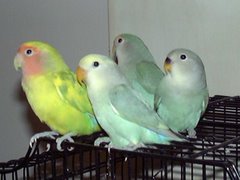Fruits, Vegetable, Berries and Weeds for Lovebirds
Most lovebirds eat some form of green food. For lovebirds it is a supplement ingredient of their diet. You can collect some green food yourself, but there may be some drawbacks to this.
The herbs, and fruits may have been contaminated by dust produced by heavy industries, exhaust fumes, or pesticides. That is why people who keep a lot of lovebirds often grow herbs in their own garden or on their balcony, so that they can be sure about the quality.
When you give green foods to the lovebirds make sure that it has not stated to wilt, rot or even become moldy. If any green food is left over, make sure you remove it the same day. Fruit should be washed very thoroughly and offered in small pieces.
Fruits and Vegetables
The following types of fruits and vegetable are suitable:
Sweet varieties of apple, pears, bananas, grapes, orange segments, mandarains, papayas, dates, figs, apricots (dried or fresh), pineapples, soaked raisins and currants, carrots, tomatoes, corncobs, celery (in small quantities). Never feed your lovebirds avocados, as these are poisonous for a lot of birds!
Berries
The following types of berries are suitable: blackberries, raspberries, hawthorn berries, elderberries, berberries, rowanberries, rose hips, firethorn berries.
Green Food
The following type of green food are suitable for lovebirds: chick weed, coltsfoot, sheperd's purse, lady's-thumb (the seeds and flowers), ground-sel, plantain, sorrel, milfol, dandelion, garden peppergrass, fresh grass seeds, evening primrose, sow thistle.
The herbs, and fruits may have been contaminated by dust produced by heavy industries, exhaust fumes, or pesticides. That is why people who keep a lot of lovebirds often grow herbs in their own garden or on their balcony, so that they can be sure about the quality.
When you give green foods to the lovebirds make sure that it has not stated to wilt, rot or even become moldy. If any green food is left over, make sure you remove it the same day. Fruit should be washed very thoroughly and offered in small pieces.
Fruits and Vegetables
The following types of fruits and vegetable are suitable:
Sweet varieties of apple, pears, bananas, grapes, orange segments, mandarains, papayas, dates, figs, apricots (dried or fresh), pineapples, soaked raisins and currants, carrots, tomatoes, corncobs, celery (in small quantities). Never feed your lovebirds avocados, as these are poisonous for a lot of birds!
Berries
The following types of berries are suitable: blackberries, raspberries, hawthorn berries, elderberries, berberries, rowanberries, rose hips, firethorn berries.
Green Food
The following type of green food are suitable for lovebirds: chick weed, coltsfoot, sheperd's purse, lady's-thumb (the seeds and flowers), ground-sel, plantain, sorrel, milfol, dandelion, garden peppergrass, fresh grass seeds, evening primrose, sow thistle.







 Free Ads For Bloggers
Free Ads For Bloggers

